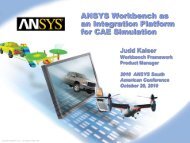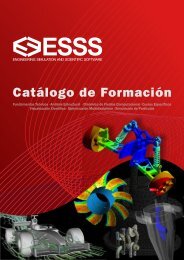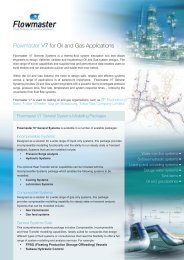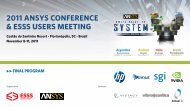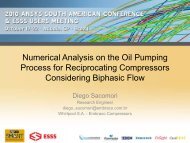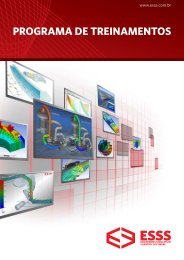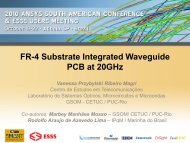Design of high performance automotive brake caliper using ... - ESSS
Design of high performance automotive brake caliper using ... - ESSS
Design of high performance automotive brake caliper using ... - ESSS
- No tags were found...
You also want an ePaper? Increase the reach of your titles
YUMPU automatically turns print PDFs into web optimized ePapers that Google loves.
<strong>Design</strong> <strong>of</strong> <strong>high</strong> <strong>performance</strong> <strong>automotive</strong><strong>brake</strong> <strong>caliper</strong> <strong>using</strong> ANSYSRafael Blumberg – AuthorNicolino Foschini Neto – Co-author
PRESENTATION TOPICS• Formula FEI Overview;• Problem Description;• Goals;• Methodology;• Conclusion and next steps.
Formula FEI Team• Formula SAE student competition
Problem Description• Mass comparison410g 810g 680g1210g1360g10% <strong>of</strong> mass reduction
Problem Description• Loads distributionNormal force on front axis [N] 2071.29 NDeceleration [g’s] 1.6 g’sNd1 aWVehicle weight [N] 2550 NNt( a)WRatio C.G. height / wheel base 0.226Rear weight distribution 54.9 %Normal force on rear axis 478.71 N
Problem Description• Brake loadsBrake torque [Nm] 378.8 NmTdNd D4pFriction tire/road coefficientTire rolling diameter [m] 1.6 0.457 mPdLine Pressure [MPa] Td*Re BF AePiston area [mm²] 4.0 MPa 1279.41 mm²Brake factor (2 * pad/disc ) 0.8Theorical effective radius [m] 0.0925 m
Problem Description• Loads distribution
Problem Description• Loads distributionCut view to analyzethe forces
Problem Description• Loads distributionPressure = 4 MPaNormal disc forcereactionCa<strong>using</strong> bypressure
Problem Description• Loads distributionAnother cut view toanalyze the forces
Problem Description• Loads distribution Friction = 0.4Tangential discforceCa<strong>using</strong> byTorque (380 Nm)
Problem Description• Effective radius
Problem Description• Effective radiusR e
Goals• <strong>Design</strong>ing the <strong>caliper</strong> to the selected position• Mass reduction• Improve rigidity• Determine effective radius
Methodology• Create the mesh184250 elements was used with 289923 nodes to mesh generation and 4 Gb<strong>of</strong> RAM memory was needed to solve.
Methodology• Verifying mesh quality (aspect ratio)
Methodology• Verifying mesh quality (aspect ratio)
Methodology• Create contact regions
Methodology• Create contact regions – pad / <strong>brake</strong> discThis contact is responsible to transform pressure in torque
Methodology• Create contact regions – piston / padThis contact determine how much force is transferred to bodyand how much remains on pin
Methodology• Create contact regions – piston / bodyThis contact is important because it is the unique contact that holds the<strong>brake</strong> disc at its position, and also, it is responsible to set <strong>caliper</strong>’s efficiencyand piston solicitation
Methodology• Double check contact regions gaps and penetrations
Methodology• Pressures, torques and supports
Methodology• Pressures, torques and supportsCylindrical support used withtangential and axial free,because at this simulation wasused fixed <strong>caliper</strong> and floatingdisc
Methodology• Pressures, torques and supportsCompression only support was selected to give a real condition at holes,although it requires more process time
Methodology• Pressures, torques and supportsThis displacement needed be used to hold the <strong>caliper</strong> on axial holes directionbecause compression only support give that freedom
Methodology• Pressures, torques and supports380 Nm moment applied, same valueas calculated at begin based onvehicle characteristics
Methodology• Pressures, torques and supports4 MPa pressure applied at every piston case, fluid lineand pistons
Methodology• Double check reaction torque at same surface that wasapplied <strong>brake</strong> torque
Methodology• Double check reaction torque at same surface that wasapplied <strong>brake</strong> torqueWas applied 380 Nm, but was obtained 338 Nm.380 ---------------- 338X ---------------- 380Torque necessary to be applied is 426 Nm in order to obtain 380 Nm as realapplied
Methodology• Double check reaction torque at same surface that wasapplied <strong>brake</strong> torque
Conclusion and next steps• Results (Equivalent Stress – All bodies)
Conclusion and next steps• Results (Equivalent Stress – All bodies)
Conclusion and next steps• Results (Total Deformation – All bodies)
Conclusion and next steps• Results (Equivalent Stress – Body)
Conclusion and next steps• Results (Z deformation – Body)
Conclusion and next steps• Results (Z deformation – Body)
Conclusion and next steps• Results (Equivalent Stress – Pads)
Conclusion and next steps• Results (Equivalent Stress – Piston)
Conclusion and next steps• Results (Equivalent Stress – Pins)
Conclusion and next steps• Results (Contact Pressure – Pad / Disc)
Conclusion and next steps• It’s possible to analyze a <strong>brake</strong> <strong>caliper</strong> with good precisionwithout to need a <strong>high</strong> level computer• Start simulation with thermical DOF <strong>using</strong> friction heatgeneration
THANKSPr<strong>of</strong>. Dr. Roberto Bortolussi



